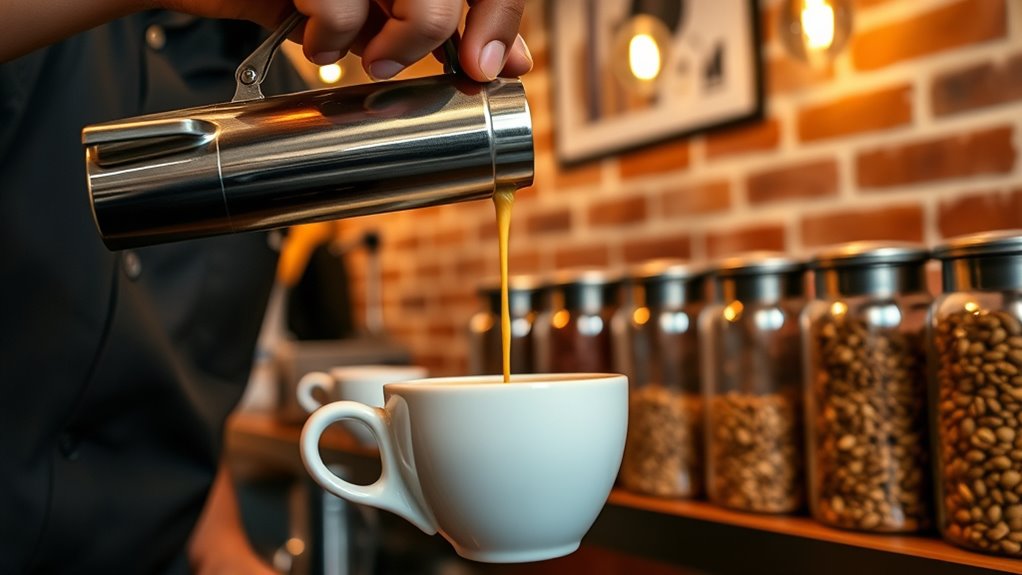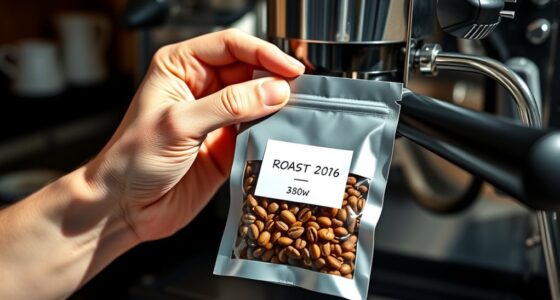Third Wave Coffee marks a new era by emphasizing transparency, craftsmanship, and regional flavors. It encourages you to appreciate coffee’s origin, traceability, and flavor nuances through specialty brewing methods like pour-overs and light roasts. Baristas often guide you in sensory exploration, while packaging shares stories of farms and farmers. If you’re curious about how this movement elevates your coffee experience and what makes it different, there’s much more to discover beyond the surface.
Key Takeaways
- Emphasizes transparency, ethical sourcing, and traceability of single-origin beans to elevate coffee as a craft.
- Focuses on precise brewing techniques like pour-overs and light roasting to highlight regional flavor nuances.
- Promotes tasting experiences and sensory education, treating coffee as a form of artistry and craftsmanship.
- Incorporates minimalist design and detailed packaging to enhance the consumer experience and storytelling.
- Inspires a global movement that values quality, sustainability, and community engagement in coffee culture.

Have you ever wondered how coffee evolved from a mass-produced commodity to an artisanal craft? It all started with a shift in mindset that gained momentum in the late 20th century. While the term “Third Wave Coffee” was coined in 1999, its roots stretch back to the 1970s U.S. coffee culture, when pioneers like Coffee Connection began emphasizing quality and creativity.
This movement emerged as a response to the “Second Wave” era, which focused on consistency and convenience but often sacrificed flavor and transparency. Now, the goal is to elevate coffee to the status of fine wine or craft beer, emphasizing craftsmanship, origin, and ethical practices.
In this new era, focus on origin and traceability becomes essential. You’ll find cafes emphasizing single-origin beans, highlighting regional flavor profiles like Ethiopian floral notes or Kenyan bright acidity. These beans are carefully sourced through direct trade relationships that prioritize transparency and fairness.
By working directly with growers, producers improve their farm economics and guarantee better quality beans. Micro-lot purchases further emphasize terroir-specific characteristics, making each cup a reflection of its unique environment. This approach also values seasonal harvesting, so your coffee experience aligns with harvest cycles, bringing freshness and variety throughout the year.
Roasting practices now tailor profiles to each bean’s origin instead of standard blends. Light to medium roasts are favored to preserve natural acidity and fruit notes, often roasted in small batches to secure freshness and consistency. Roast dates are prominently displayed, so you can enjoy beans at their peak flavor.
Roasters experiment with airflow and temperature, revealing hidden flavors and nuances. This meticulous approach to roasting complements brewing methods that prioritize precision, such as manual pour-overs like the Hario V60 or Chemex. These techniques allow for nuanced extraction, emphasizing clarity, aroma, and acidity—elements that parallel wine tasting.
Brewing isn’t just about convenience anymore; it’s about craftsmanship. You might experiment with immersion methods like French Press or AeroPress, or explore cold brew for smooth, low-acidity profiles. Baristas often guide you through tasting flights, comparing regional profiles side-by-side, educating you on how variables like grind size, water temperature, and brewing time influence flavor.
Coffee shops tend to feature minimalist designs that avoid sensory distraction, letting the coffee itself take center stage. Packaging often includes detailed tasting notes and stories about the farms, connecting you directly to the origins of your beans.
This movement has sparked a global impact, inspiring specialty coffee cultures across Europe, Asia, and Latin America. Consumers are increasingly willing to pay premiums for traceable, ethically sourced coffee. Cafés are transforming into community spaces for education and connection, while the home brewing market flourishes with advanced grinders, scales, and equipment. Additionally, educational resources are widely available to deepen your understanding of coffee science and appreciation.
Frequently Asked Questions
How Does Third Wave Coffee Impact Global Coffee Farming Communities?
You see, third-wave coffee positively impacts global farming communities by promoting fair trade and direct relationships. You help guarantee farmers receive fair wages, which supports sustainable practices and community development.
You also encourage environmentally friendly methods, preserving biodiversity and reducing harm. By choosing third-wave coffee, you contribute to stronger, healthier communities, preserving cultural traditions, and fostering long-term partnerships that benefit farmers and their families worldwide.
What Are the Environmental Benefits of Third Wave Coffee Practices?
You see, sustainable coffee practices offer significant environmental benefits. By supporting regenerative agriculture, organic farming, and biodiversity preservation, you help improve soil health, reduce chemical runoff, and protect ecosystems.
Water conservation methods lower waste, while carbon sequestration mitigates climate change. These practices also promote reforestation and pollinator health, ensuring that coffee cultivation benefits the environment.
Your choices encourage eco-friendly methods, making coffee production more sustainable and reducing its overall environmental footprint.
How Can Consumers Identify Authentic Third Wave Coffee?
Imagine discovering a hidden gem when you pick your coffee. To identify authentic third wave coffee, look for transparency about its origin and sourcing. Check if it’s single-origin, ethically traded, and produced with sustainable practices.
Ask about the roasting and brewing methods used. When you see detailed stories about the farmers and quality-focused processes, you’re likely enjoying genuine third wave coffee that celebrates craft and care.
What Are the Common Brewing Techniques Used in Third Wave Coffee Shops?
You’ll find that common brewing techniques include pour-over methods like V60 and Kalita Wave, which emphasize clarity and brightness.
You might also use AeroPress or Chemex for a balanced, clean cup, and French press for a fuller body.
Precise control of grind size, water temperature, and brew time plays a key role.
These techniques highlight the coffee’s unique flavors, allowing you to appreciate its nuanced profile.
How Does Third Wave Coffee Influence Coffee Pricing and Accessibility?
Imagine you’re exploring a vibrant marketplace where rare spices command high prices. Similarly, third wave coffee‘s focus on quality, ethical sourcing, and unique flavors drives prices upward.
You find that accessibility expands through online platforms and cafes, yet economic forces like inflation and market fluctuations can make premium coffee less affordable.
Your appreciation grows as transparency and innovation bring this artisanal experience closer, balancing exclusivity with wider reach.
Conclusion
As you immerse yourself in the world of third wave coffee, you’re not just savoring a drink—you’re tasting artistry and passion brewed to perfection. This movement transforms each cup into a canvas of flavors, inviting you to appreciate the craft behind every sip. So, next time you enjoy your coffee, remember you’re part of a revolution that elevates a simple beverage into an experience as rich and layered as a symphony—delighting your senses and awakening your appreciation.









